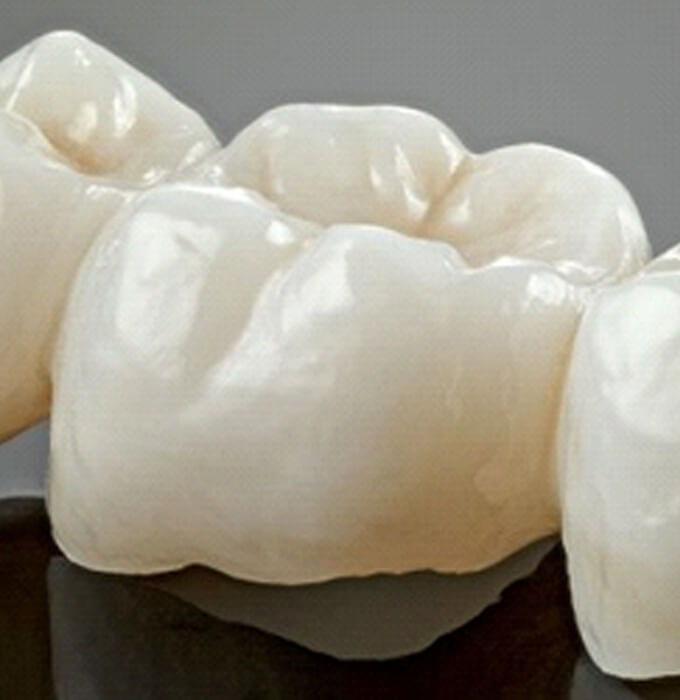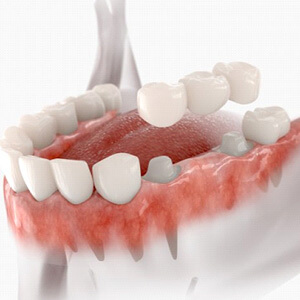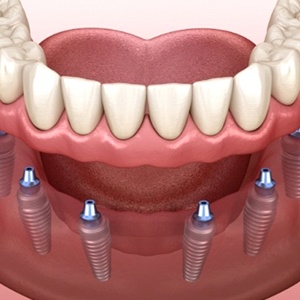
Dental Bridges – Lansing, MI
Complete Your Smile with a Beautiful and Lifelike Restoration
Do you have one or more missing teeth that make you feel reluctant to show off your smile? Fortunately, our office in Lansing can provide you with modern restorative dental treatments that can get your grin back in shape. If you are missing one or more teeth in a row, a dental bridge can be a great way to fill the gap with something that doesn’t just look lifelike but functions optimally. Contact our office today to learn more about what dental bridges may be able to do for you.
Why Choose Healthy Smiles Dental Care of Lansing for Dental Bridges?

- Skilled and Experienced Dentists
- Clean and Comfortable Office
- Lifelike and Functional Restorations
What Is a Dental Bridge?

A dental bridge consists of one or more prosthetic teeth that are situated between two dental crowns. These crowns can be placed on the healthy teeth on either side of a gap, filling it with natural-looking artificial teeth. Bridges are designed to match the existing smile and preferences of each individual patient, meaning they’re an excellent way to restore missing teeth. In fact, they look so lifelike that most people won’t be able to tell that you have one!
Types of Dental Bridges

Dentists have used dental bridges to treat patients for centuries, and they come in two different types. Consulting with our team can help you determine which of them is a good fit for you.
Traditional Dental Bridge

Traditional bridges depend on dental crowns to hold them in place and keep them stable during chewing, and they are usually suitable if you have one or two teeth to replace. The patient will need healthy teeth on either side of the empty space to host the crowns, and these teeth will have to be altered for the crowns to be placed. If these teeth have any tooth decay, they cannot serve as a strong foundation for the crowns.
Implant Bridge

If you’ve lost three or more consecutive teeth, an implant bridge may be the best option. Rather than using crowns, these bridges rely on dental implants to hold them in position. Placing an implant bridge will require several months’ recovery time so that the implants can fuse completely with the jawbone, but they do not require any alteration of healthy teeth. Dental implants also create a sturdier foundation than dental crowns, making chewing with an implant bridge easier.
The Benefits of Getting a Dental Bridge

Dental bridges are a great way to replace missing teeth for many reasons, a few of them being:
- They can help prevent your teeth from drifting out of alignment, which can occur after tooth loss.
- Your bridge will fit in seamlessly with the rest of your smile.
- You can enjoy having a full smile again.
- Dental bridges can be brushed exactly like natural teeth.
- With proper care, a dental bridge can last upwards of fifteen years.
Dental Bridges FAQs
Can Dental Bridges Get Cavities?
A dental bridge should never be able to develop a cavity—but your natural teeth around and beneath it will still be vulnerable to decay. This can be due to the accumulation of food debris under the pontics or between the space where your crowns meet the gumline. Bacteria can end up settling in these places and lead to the formation of cavities. The best way to keep this from occurring is by maintaining great oral hygiene every day and making sure to clean around and under the bridge daily.
Do Dental Bridges Look Natural?
Our team provides dental bridges that are constructed out of tooth-colored, metal-free materials. This means that your prosthetic should be capable of blending seamlessly with the rest of your smile, as the artificial teeth will be shaped and colored to mimic your natural pearly whites. You also shouldn’t have to worry about your new teeth shifting around like an ill-fitted denture, so you can feel comfortable and confident with your smile whenever you’re enjoying a meal or conversing with loved ones.
How Many Teeth Can a Dental Bridge Replace?
This will typically depend on a patient’s dental needs, but, generally speaking, a dental bridge will be able to replace one to four consecutively missing teeth. That said, the majority of the time, this kind of prosthetic will be reserved for patients who are missing one or two teeth in a row. This is because a longer bridge can end up becoming too unstable, especially if the abutment teeth on either side of the gap aren’t sufficiently stable or healthy enough. The more teeth you need to replace, the more likely you might have to opt for an implant bridge for more reliable stability.
Can You Take a Dental Bridge Out?
Unlike with traditional dentures, you should not be able to remove your dental bridge on your own. These prosthetics are designed to look like your natural teeth and remain in your mouth indefinitely. The only one who should be capable of taking it out is your dentist. Certain healthcare professionals might accidentally refer to partial dentures as “removable bridges,” but this doesn’t point to the truth. While partials might appear like dental bridges in that they can replace a few teeth in a row, you’ll be able to remove the denture, while the dental bridge will remain in your mouth.